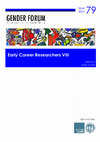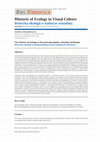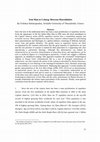MA Thesis Chapters by Evdokia Stefanopoulou
Papers by Evdokia Stefanopoulou

Journal of the Fantastic in the Arts, 2023
This article explores articulations of the posthuman in two millennial post-apocalyptic films, I ... more This article explores articulations of the posthuman in two millennial post-apocalyptic films, I Am Legend and Mad Max: Fury Road. Using Rosi Braidotti’s posthuman theory, this article argues that despite the humanist trajectory of I Am Legend’s protagonist the film still expresses the notion of becoming-posthuman but in a latent form—through specific narrative and visual elements, but also via its alternate ending. This research labels these concealed expressions of the posthuman “latent posthumanism,” a tendency that is also evident in most contemporary Hollywood post-apocalyptic films with male leads. The essay then moves on to discuss Mad Max: Fury Road, as a rare case of blockbuster film where this latent posthumanism becomes explicit mainly through its female protagonist and its ecofeminist discourses. Both films suggest the potential of the post-apocalyptic film to provide important insights into expanded notions of subjectivity beyond the human.
Science Fiction Film & Television, 2023
This essay focuses on a rather unexplored side of sf history, namely the impact of modern art on ... more This essay focuses on a rather unexplored side of sf history, namely the impact of modern art on sf iconography. The first section introduces new associations between modernist artworks with science fictional ideas and images. The subtle relation between modern art and sf has been largely ignored by the relevant literature, and this essay therefore aims to illuminate this overlooked association. The second section discusses the artwork of sf illustrators as an acknowledged expression of the genre that bears an implicit and sometimes explicit influence from the modernist tropes and ideas discussed in the first part. I argue that the science fictional ideas found in modernist artworks and sf illustrations can be considered as precursors to the imaginings of sf cinema.

Gender Forum, 2021
Gender forum is an online, peer reviewed academic journal dedicated to the discussion of gender i... more Gender forum is an online, peer reviewed academic journal dedicated to the discussion of gender issues. As an electronic journal, gender forum offers a free-of-charge platform for the discussion of gender-related topics in the fields of literary and cultural production, media and the arts as well as politics, the natural sciences, medicine, the law, religion and philosophy. Inaugurated by Prof. Dr. Beate Neumeier in 2002, the quarterly issues of the journal have focused on a multitude of questions from different theoretical perspectives of feminist criticism, queer theory, and masculinity studies. gender forum also includes reviews and occasionally interviews, fictional pieces and poetry with a gender studies angle. Opinions expressed in articles published in gender forum are those of individual authors and not necessarily endorsed by the editors of gender forum. Submissions Target articles should conform to current MLA Style (8th edition
CINEJ Cinema Journal
The HBO limited television series Watchmen (2019) represents a politically engaged superhero tele... more The HBO limited television series Watchmen (2019) represents a politically engaged superhero television show, marking a shift in recent efforts to render the genre more inclusive in terms of gender and race. Specifically, in mixing fictional and real events surrounding racial violence, such as the 1921 Tulsa massacre, Watchmen inscribes the potential of the superhero genre to tackle prescient political issues and social anxieties, that became even more poignant in the wake of the 2020 George Floyd protests. The present paper explores Watchmen’s deep resonances with contemporary social and political issues, not only at the level of representations, but also at the series’ production context, and argues that the show marks a key moment in the politicization of the superhero genre.

Contemporary post-apocalyptic fi lms portray a world ravaged by ecological catastrophes, and huma... more Contemporary post-apocalyptic fi lms portray a world ravaged by ecological catastrophes, and humanity on the brink of extinction. Such fi lms echo the urgent environmental discourses of the Anthropocene, while offering instances of a post-anthropocentric perspective and the new subject-formations it engenders. The article argues that the central rhetorical device that generates an ecocritical perspective in such fi lms is the post-apocalyptic landscape. Cinematic space shapes the meaning of all fi lms, and this is even more emphatic when setting is transformed into landscape (Lefebvre 2006). What is more, in the post-apocalyptic fi lms, the landscape becomes the main site of the fi lms' "rhetorical enviromentality" (McMurry 2017). The article examines the post-apocalyptic landscape in I Am Legend (2007) and Mad Max: Fury Road (2015) and how it articulates the entangled relation between humans and the collapsing world that surrounds them. Using Rosi Braidotti's (2013) post-human theory, I contend that these cinematic landscapes hint at an "eco-philosophy of multiple belongings" (Braidotti 2013, 49) and enact "a process of redefi ning one's sense of attachment and connection to a shared world" (Braidotti 2013, 219). Ultimately, I conclude that the affective appeal of these landscapes implicates the viewer in post-anthropocentric perspectives, thus prompting new modes of environmental consciousness.

Since the turn of the millennium there has been a mass proliferation of superhero movies. From th... more Since the turn of the millennium there has been a mass proliferation of superhero movies. From the appearance of the fist Spider-Man film in 2002 since the latest installment in the Captain America series (2016), superhero movies have a tremendous popular and economic success. These popular texts have also a massive cultural impact by articulating their representations and ideologies in a global audience consisting of different national, racial, class and gender identities. The gender issues in superhero movies are often accompanied by the common observation that the great majority of superheroes are men and the rare presence of women is marked by their placement in a supporting role, thus reproducing a patriarchal ideology. Although this phenomenon can indeed be characterized as an excessive demonstration of masculine power and superheroes can be seen as mythical figures of a technological patriarchy, I would also suggest a different approach, an antithetical reading. This approach examines the overstated " technological sublime in human form " (Wasielewski 66) as a sort of divergent embodiment of subjectivity, one that contains the notion of the cyborg as described by Donna Harraway, one containing its own blurring of the ontological boundaries (161), therefore projecting its own existence as a social construction. Deploying this approach, I would examine the gender representations in the Iron Man trilogy (2008, 2010, 2013) not as demonstration of patriarchal power, but as masculinity in crisis, a masculinity undermined by its excessive technological look and its status as a constructed fabrication. A close analysis of the three texts and a special focus on gender representations will demonstrate how the technological subjectivity of Iron Man and the ironic performance by Robert Downey Jr. actually undermines the surface super-masculinity of the character. Finally, some general conclusion from the above analysis will be drawn.
Book Chapters by Evdokia Stefanopoulou

Feminist Posthumanism in Contemporary Science Fiction Film and Media: From Annihilation to High Life and Beyond (ed.Julia A. Empey, Russell J.A. Kilbourn), 2023
Annihilation (2018) narrates the events surrounding the discovery of a time-space anomaly on Eart... more Annihilation (2018) narrates the events surrounding the discovery of a time-space anomaly on Earth called ‘the Shimmer’. The Shimmer functions like a prism, refracting DNA from all living organisms it enfolds, and collapsing the limits between humans, animals, and plants. This dissolution of boundaries engenders strange corporeal reconfigurations that enact the “entangled material agencies” (Barad 2007, 56) that co-constitute both the human and non-human worlds. The chapter examines Annihilation through the lens of Karen Barad’s (2007) agential realism, and specifically though the concept of diffraction which is associated with the film’s themes. This notion is also articulated in the visual style, mainly though the trope of the fractal that permeates the images of the film. The chapter then examines how these material entanglements are also related to the grotesque and the double sensation it provokes to both characters and viewers. The grotesque as theorized by Bakhtin signifies as an affirmative corporeality; however, in popular culture it is also connected with feelings of repulsion and disgust. The film’s grotesque images thus engender both fascination and aversion. What is more, as a female-centric film, Annihilation links these grotesque transformations with the female body. This correlation of the grotesque posthuman transformation with the female body is explored in the last section. I discuss the representation of Annihilation’s female characters, and specifically how their posthuman becoming is signified and experienced in an ambiguous way, that hints at the subversive possibilities of these transfigurations, but at the same time remains bounded within humanist discourses.

The Films of Antoinetta Angelidi (eds. Penny Bouska and Sotiris Petridis), 2023
Abstract
Antoinetta Angelidi’s cinema has been characterized as non-narrative, poetic, or visual... more Abstract
Antoinetta Angelidi’s cinema has been characterized as non-narrative, poetic, or visual. Indeed, her unique visual style and imagery often eludes classification, thus exemplifying a central aspect of the experimental film. Angelidi’s work has also been discussed in relation with the dream-mechanism, defamiliarization and the uncanny. Despite the unquestionable centrality of the uncanny in Angelidi’s work the present essay suggests another related concept that can describe her cinema: the sublime. The sublime and the uncanny are associated, since the latter has been described as “the aesthetic outgrowth of the Burkean sublime, a domesticated version of absolute terror.” Similar with the uncanny, the sublime in Angelidi’s cinema does not refer to themes, as for example in the case of fantastic films where the sublime is associated with the representation of spectacular vistas or extraordinary phenomena. Rather the sublime refers to the production of certain rhetorical and poetic effects that shape the director’s unique cinematic language. The aim of this essay is to describe how Angelidi’s Thief or Reality (2001) expresses the sublime in cinematic form. Using as a theoretical context Burke’s and Kant’s treatises of the sublime, while also expanding in notions of sublimity in art and more specifically in cinema, the essay argues that Angelidi’s Thief or Reality articulates a unique cinematic sublimity, enabling the expansion and transformation of cinematic vision.
Book by Evdokia Stefanopoulou

The Science Fiction Film in Contemporary Hollywood: A Social Semiotics of Bodies and Worlds, 2023
The Science Fiction Film in Contemporary Hollywood focuses on the American science fiction (SF) f... more The Science Fiction Film in Contemporary Hollywood focuses on the American science fiction (SF) film during the period 2001-2020, in order to provide a theoretical mapping of the genre in the context of Conglomerate Hollywood. Using a social semiotics approach in a systematic corpus of films, the book argues that the SF film can be delineated by two semiotic squares-the first one centering on the genre's more-than-human ontologies (SF bodies), and the second one focusing on its imaginative worlds (SF worlds). Based on this theoretical framework, the book examines the genre in six cycles, which are placed in their historical context, and are analyzed in relation to cultural discourses, such as technological embodiment, race, animal-human relations, environmentalism, global capitalism, and the techno-scientific Empire. By considering these cycles-which include superhero films, creature films, space operas, among others-as expressions of the genre's basic oppositions, the book facilitates the comparison and juxtaposition of films that have rarely been discussed in tandem, offering a new perspective on the multiple articulations of the SF film in the new millennium.

Uploads
MA Thesis Chapters by Evdokia Stefanopoulou
Papers by Evdokia Stefanopoulou
Book Chapters by Evdokia Stefanopoulou
Antoinetta Angelidi’s cinema has been characterized as non-narrative, poetic, or visual. Indeed, her unique visual style and imagery often eludes classification, thus exemplifying a central aspect of the experimental film. Angelidi’s work has also been discussed in relation with the dream-mechanism, defamiliarization and the uncanny. Despite the unquestionable centrality of the uncanny in Angelidi’s work the present essay suggests another related concept that can describe her cinema: the sublime. The sublime and the uncanny are associated, since the latter has been described as “the aesthetic outgrowth of the Burkean sublime, a domesticated version of absolute terror.” Similar with the uncanny, the sublime in Angelidi’s cinema does not refer to themes, as for example in the case of fantastic films where the sublime is associated with the representation of spectacular vistas or extraordinary phenomena. Rather the sublime refers to the production of certain rhetorical and poetic effects that shape the director’s unique cinematic language. The aim of this essay is to describe how Angelidi’s Thief or Reality (2001) expresses the sublime in cinematic form. Using as a theoretical context Burke’s and Kant’s treatises of the sublime, while also expanding in notions of sublimity in art and more specifically in cinema, the essay argues that Angelidi’s Thief or Reality articulates a unique cinematic sublimity, enabling the expansion and transformation of cinematic vision.
Book by Evdokia Stefanopoulou
Antoinetta Angelidi’s cinema has been characterized as non-narrative, poetic, or visual. Indeed, her unique visual style and imagery often eludes classification, thus exemplifying a central aspect of the experimental film. Angelidi’s work has also been discussed in relation with the dream-mechanism, defamiliarization and the uncanny. Despite the unquestionable centrality of the uncanny in Angelidi’s work the present essay suggests another related concept that can describe her cinema: the sublime. The sublime and the uncanny are associated, since the latter has been described as “the aesthetic outgrowth of the Burkean sublime, a domesticated version of absolute terror.” Similar with the uncanny, the sublime in Angelidi’s cinema does not refer to themes, as for example in the case of fantastic films where the sublime is associated with the representation of spectacular vistas or extraordinary phenomena. Rather the sublime refers to the production of certain rhetorical and poetic effects that shape the director’s unique cinematic language. The aim of this essay is to describe how Angelidi’s Thief or Reality (2001) expresses the sublime in cinematic form. Using as a theoretical context Burke’s and Kant’s treatises of the sublime, while also expanding in notions of sublimity in art and more specifically in cinema, the essay argues that Angelidi’s Thief or Reality articulates a unique cinematic sublimity, enabling the expansion and transformation of cinematic vision.